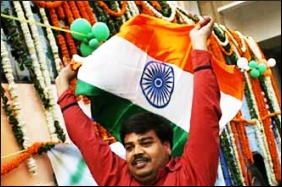|

|
India's reforms go beyond face value
|
|

|
|
| Top Stories |
 |
|
|
|
Arvind Padmanabhan | 23 Oct, 2012
The battery of reformist decisions taken by Prime Minister Manmohan
Singh government in the past month not just alter the perception of
policy inaction in India, but will also go a long way in reviving the
country's slowing economy and stabilise state finances.
There is a
flip side as well, which is equally important. Had these decisions been
kept in abeyance any longer, the negative impact on account of that
would have damaged the economy and India's image in a manner that would
have taken a long time to mend.
Among them, at the top was a
threat of ratings downgrades by agencies such as Standard and Poor's and
Moody's. A downgrade would not just have assigned junk status to Indian
bonds and rendered them untouchable, but also frozen inflow of foreign
funds.
Both foreign institutional and capital investors would
have compulsorily stopped their money flow to India. There would have
also been a flight of capital to the extent that the country's external
debt situation would have fallen into bad times - like in 1991.
Also,
with the rupee already dancing in a range of around Rs.51 and Rs.55 to a
dollar, a downgrade would have depreciated the value of the currency
even further, making not just the import of crude oil dearer but also
fanned inflation further - a political disaster!
In fact, the
global ratings agencies had said that some action on insurance, pension
and other areas like foreign equity in multi-brand retail trade is what
will may make them re-think on not downgrading India's rating, having
put the country on watch.
But with these big bang actions since
Sep 13 with as many as 21 decisions taken Thursday alone, the United
Progressive Alliance (UPA) government has ensured some of the ominous
reactions are staved off -- at least in the medium term.
Not that
these decisions will result in immediate flow of capital from overseas
into the insurance and pension sectors. What the federal cabinet cleared
and approved were some legislative actions that are needed to give
these decisions effect.
But what one can surely now expect is a
step up in investments by foreign institutional investors, that have
already pumped $21.3 billion into India's equity and debt markets during
this year, and helped nurse the indices to a 15-month high.
Even
the harshest decisions yet, of hiking the diesel prices and limiting
the subsidy on domestic cooking gas to six cylinders per annum, send a
message that the government will no longer compromise on fiscal
stabilty.
Politically, the decisions on pension and insurance
have the possibility of support from the opposition Bharatiya Janata
Party. The cabinet accepted most of the recommendations made by the
Parliamentary Standing Committee on Finance under BJP's Yashwant Sinha.
The
only point real point of contention is: The committee wanted the 26
percent cap on foreign investment in insurance business retained, while
the cabinet proposed a 49 percent. In the least, this only ensures the
entry of foreign capital into pension.
These two industries have
been crying for reforms. By making it clear that the state-run companies
in these two areas will remain under government control, the cabinet
also sought to assuaged the feelings of the powerful trade unions in
these companies.
India's insurance industry is valued at $41
billion with 24 companies in life insurance business and 27 in the
general insurance category. The penetration of insurance cover is poor
at just 4.4 percent of the population in life, and 0.71 in non-life
business.
In pension, official data shows that a mere 12 percent
of India's working population has some form of a retirement benefit.
Only recently was this industry opened to domestic players with the
regulator allowing seven fund managers to seek fresh investments.
If
and when parliament approves the relevant legislations, Indian
insurance and pension industries will not just get fresh doses of
capital, so vital to cushion against risks and spur growth, but people
can also expect new schemes that suit their needs.
According to
some insiders, Thursday's cabinet meeting, like the one on Sep 13, had
one striking feature. Prime Minister Manmohan Singh left little room for
debate -- 21 policy approvals over two hours translates into less than
six minutes per decision.
The Supreme Court too in a recent
decision did its bit to clear the path of reforms by saying
policy-making was the executive's prerogative. Judiciary had no role in
that.
These are signals that one hasn't yet heard the last word on economic reforms in India.
* Arvind Padmanabhan is Executive Editor - Business with IANS. The
views expressed are personal. He can be reached at arvind.p@ians.in
|
|
|
| |
|
|
|
|
|
|
|
|
|
|
|
|
|
|
| |
| Customs Exchange Rates |
| Currency |
Import |
Export |
US Dollar
|
84.35
|
82.60 |
UK Pound
|
106.35
|
102.90 |
Euro
|
92.50
|
89.35 |
| Japanese
Yen |
55.05 |
53.40 |
| As on 12 Oct, 2024 |
|
|
| Daily Poll |
 |
 |
| Do you think Indian businesses will be negatively affected by Trump's America First Policy? |
|
|
|
|
|
| Commented Stories |
 |
|
|
|
|
|
| |
|